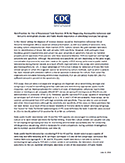For Clinicians
Clinical Features
Disease caused by Haemophilus influenzae can affect many organ systems. The most common types of disease caused by H. influenzae type b (Hib) include pneumonia, bacteremia, meningitis, epiglottitis, septic arthritis, cellulitis, otitis media, purulent pericarditis, and other less common infections such as endocarditis and osteomyelitis. Non-b H. influenzae can cause disease similar to Hib infections. Nontypeable H. influenzae commonly causes ear infections in children and bronchitis in adults, but also causes invasive disease, such as bacteremia and bacteremic pneumonia.
Etiologic Agent
H. influenzae is a pleomorphic gram-negative coccobacillus. H. influenzae may be either encapsulated (typeable) or unencapsulated (nontypeable). There are six encapsulated serotypes (designated a–f) that have distinct capsular polysaccharides.
Sequelae
Between 3% to 6% of Hib cases in children are fatal; up to 20% of patients who survive Hib meningitis have permanent hearing loss or other long-term neurological sequelae. Patients ≥65 years of age with invasive H. influenzae disease (Hib, non-b, and nontypeable) have higher case-fatality ratios than children and young adults.
Key Resource
New!
Best Practices for Use of Polymerase Chain Reaction (PCR) for Diagnosing Haemophilus influenzae and Neisseria meningitidis Disease and Public Health Importance of Identifying Serotype/Serogroup
Transmission
Transmission occurs through direct contact with respiratory droplets from nasopharyngeal carrier or case patient. Neonates can acquire infection by aspiration of amniotic fluid or contact with genital tract secretions containing the bacteria.
Risk Groups
Unimmunized children younger than 4 years of age, as well as household contacts and daycare classmates of a person with Hib disease are at increased risk of Hib disease. Increased risk for disease among close contacts of patients with non-b or nontypeable H. influenzae has not been identified. Patients with sickle cell disease, asplenia, HIV, and certain immunoglobulin and complement component deficiencies, as well as recipients of hematopoietic stem cell transplant and chemotherapy or radiation therapy for malignant neoplasms are at increased risk for invasive H. influenzae disease. American Indians and Alaska Natives are also at increased risk for invasive H. influenzae disease.
Incidence
In the United States, Hib disease occurs primarily in underimmunized children and in infants too young to have completed the primary immunization series. In developing countries, where routine vaccination with Hib vaccine is not widely available, Hib remains a major cause of lower respiratory tract infections in infants and children.
The epidemiology of invasive H. influenzae disease in the United States has shifted since the introduction of the Hib vaccine. The largest burden of invasive H. influenzae disease now occurs in children younger than 5 years of age and adults 65 years of age or older. Nontypeable H. influenzae now causes the majority of invasive H. influenzae disease in all age groups. From 2009 through 2014, the annual incidence of invasive nontypeable H. influenzae disease was 1.7 cases per 100,000 children younger than 5 years of age and 5.0 cases per 100,000 adults 65 years of age or older. Nontypeable H. influenzae also causes 30% to 52% of episodes of acute otitis media and sinusitis in children and is a common cause of recurrent otitis media.
Trends
Since licensure of conjugate vaccines for infants (1990) and children (1987), rates of Hib disease among children younger than five years old have declined by 99% in the United States, while rates for adults have remained stable. However, rates of disease among Alaska Natives remain higher than elsewhere in the United States. Nontypeable disease now causes the majority of invasive H. influenzae disease among all age groups in the United States.
Treatment and Chemoprophylaxis
For guidelines on treatment and chemoprophylaxis for invasive Hib disease, see the Red Book. Chemoprophylaxis is only recommended for Hib cases because disease among close contacts has not been identified with other types of H. influenzae.
Immunization
Hib vaccine is one of the recommended routine childhood immunizations in the United States. Currently, three monovalent conjugate Hib vaccines and two combination vaccines that contain Hib conjugate are available. An infant primary series (2, 4, and 6 months of age or 2 and 4 months of age, depending on the vaccine type used) and a booster dose at 12 through 15 months of age is recommended. Please see the United States Childhood and Adolescent immunization schedule for more information. There are no vaccines for non-b and nontypeable H. influenzae.
Reporting
All cases of invasive H. influenzae (Hib, non-b, and nontypeable) should be reported to CDC through the local or state public health department.
References
- Briere EC, Rubin L, Moro PL, Cohn A, Clark T, Messonnier N. Prevention and Control of Haemophilus influenza Type b Disease: Recommendations of the Advisory Committee on Immunization Practices (ACIP).. MMWR. 2014;63(RR01):1–14.
- Blain A, MacNeil, J, Wang X, et al. Invasive Haemophilus influenzae disease in adults ≥65 years, United States, 2011. Open Forum Infect Dis. 2014;1(2): ofu044.
- MacNeil JR, Cohn AC, Farley M, et al. Current epidemiology and trends in invasive Haemophilus influenzae disease—United States, 1989-2008. Clin Infect Dis. 2011;53:1230–6.
- Rubach MP, Bender JM, Mottice S, Hanson K, Weng HYC, Korgenski K, et al. Increasing incidence of invasive Haemophilus influenzae disease in adults, Utah, USA.. Emerg Infect Dis.. 2011;17:1645–50.
- Page last reviewed: July 25, 2016
- Page last updated: July 25, 2016
- Content source:


 ShareCompartir
ShareCompartir
